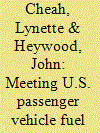|
|
|
Sort Order |
|
|
|
Items / Page
|
|
|
|
|
|
|
| Srl | Item |
| 1 |
ID:
101415


|
|
|
|
|
| Publication |
2011.
|
| Summary/Abstract |
New fuel economy standards require new U.S. passenger vehicles to achieve at least 34.1 miles per gallon (MPG) on average by model year 2016, up from 28.8 MPG today. In this paper, the magnitude, combinations and timings of the changes required in U.S. vehicles that are necessary in order to meet the new standards, as well as a target of doubling the fuel economy within the next two decades are explored. Scenarios of future vehicle characteristics and sales mix indicate that the 2016 mandate is aggressive, requiring significant changes starting from today. New vehicles must forgo horsepower improvements, become lighter, and a greater number will use advanced, more fuel-efficient powertrains, such as smaller turbocharged engines, hybrid-electric drives. Achieving a factor-of-two increase in fuel economy by 2030 is also challenging, but more feasible since the auto industry will have more lead time to respond. A discussion on the feasibility of meeting the new fuel economy mandate is included, considering vehicle production planning realities and challenges in deploying new vehicle technologies into the market.
|
|
|
|
|
|
|
|
|
|
|
|
|
|
|
|
| 2 |
ID:
175233


|
|
|
|
|
| Summary/Abstract |
Corporate Average Fuel Economy (CAFE) Standards are among the longest-running energy regulations in the United States, enduring several decades of changing political winds. First implemented in 1978, they have been adapted over time, responding to lessons learned and changing circumstances. In combination with the more recent vehicle greenhouse gas emission (GHG) standards, they have achieved enormous fuel savings and emission reductions. Until the 2018 proposed rollback, the quality of research and analysis in support of rulemakings improved dramatically with advances in analytical methods, computing power and the resources dedicated to the task. Despite the abundance of fuel economy and related data, there has been no comprehensive assessment of the standards from 1975 to the present. This paper analyzes historical data to assess the real-world impact of the standards, as well as draw lessons about energy and environmental policy design. Cumulatively, fuel economy improvements due to the standards have reduced fuel consumption by well over one and a half trillion gallons, saved consumers trillions of dollars and avoided 14 billion tons of GHG emissions. Our analysis indicates that fuel savings have exceeded the cost of improving fuel economy, traffic safety has improved and the impact on vehicle travel has been small.
|
|
|
|
|
|
|
|
|
|
|
|
|
|
|
|
|
|
|
|
|